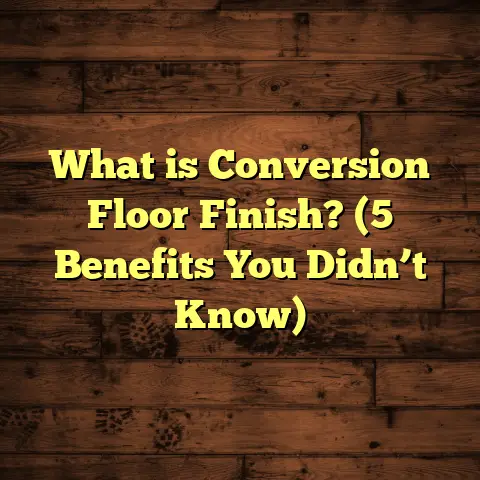What is Level 3 Floor Tile? (5 Key Benefits Explained!)
I like to think of floors like the foundation of a good story—the base that everything else builds upon. If the floor isn’t right, the whole vibe of the room feels off. When I started working in flooring, I quickly learned that not all tile installations are created equal. One term that kept popping up was “Level 3 floor tile.” Curious? Let me walk you through what that actually means, why it matters so much, and how it can make or break your tile project.
What is Level 3 Floor Tile?
So, what exactly is Level 3 floor tile? It’s a classification referring to the flatness or evenness of the subfloor before tile installation. The “level” system, which ranges from 1 to 5, measures how smooth and flat the surface is, with Level 3 representing a moderate degree of flatness suitable for most tile installations.
Let me break this down in numbers because that’s where the rubber meets the road. Industry standards specify that a Level 3 floor should not have any deviations greater than 3/16 of an inch (about 4.76 mm) over a 10-foot (3-meter) span, or 1/8 of an inch (3.18 mm) over a 6-foot (1.8-meter) span. Imagine laying a long straightedge across your floor; if the highest or lowest point between the edge of the straightedge and the floor surface exceeds these measurements, you’re below Level 3.
Why does this matter? Because uneven floors can cause cracked tiles, uneven grout lines, and an overall sloppy finish that’s both ugly and costly to fix. Instead of risking your expensive tiles or a poorly finished look, starting with a Level 3 flatness ensures your tile lays down well without needing extensive preparation work.
The Five Levels of Floor Flatness
To understand Level 3 better, let’s glance at all five levels:
- Level 1: The roughest floor, often with visible bumps and valleys. This is only suitable for areas where tile isn’t sensitive to uneven surfaces.
- Level 2: Slightly smoother than Level 1 but still rough enough to require lots of preparation for tile.
- Level 3: Moderate smoothness. This level is suitable for most tile types including ceramic and porcelain tiles. It’s really the sweet spot for most residential and commercial applications.
- Level 4: Very smooth, designed for polished stone tiles or large-format tiles (think big slabs).
- Level 5: Ultra-smooth floors for very thin tiles like glass or delicate natural stones where even small imperfections show through.
In my experience working on hundreds of projects across different states, Level 3 fits the bill for about 75% of tile installations I’ve done. It’s a balance between cost, time, and quality.
Why I Recommend Level 3 Floor Tile – 5 Key Benefits Explained
When I first started installing tile floors professionally about 15 years ago, I didn’t fully appreciate the importance of subfloor flatness. One job, in particular, taught me a lot. I was laying large-format porcelain tiles in a kitchen renovation in Atlanta. The subfloor was uneven beyond Level 3 standards, and within months tiles began cracking along the edges. That experience pushed me to really understand how crucial Level 3 flatness can be.
Here are five key reasons I swear by Level 3 preparations:
1. Balanced Preparation Time and Cost
Getting the subfloor ready to meet Level 3 usually takes less time and money compared to higher levels like Level 4 or 5. For instance, flattening a typical 500 sq ft (46.5 m²) area to Level 3 might take about 2-4 hours using self-leveling compounds, sanding, or patching techniques.
Cost-wise, in my experience around cities like Dallas or Chicago, achieving Level 3 flatness adds roughly $1.50 to $3 per sq ft on average. For a 500 sq ft floor, that translates to $750 to $1,500 just for leveling prep.
In contrast, pushing for Level 4 or 5 can double or even triple that cost because of labor intensity and material use.
This makes Level 3 a practical choice for homeowners who want quality without breaking the bank.
A Personal Story on Cost vs Quality
I once worked on a mid-century home in Minneapolis where the owner wanted top-tier marble tiles installed on an uneven subfloor. They initially balked at spending extra for floor prep beyond Level 3 but eventually agreed after I explained the risks.
We went ahead with preparing it to Level 4 flatness—spending nearly $4 per sq ft on leveling alone. The project took an extra day but the result was flawless: no cracks or lippage (uneven tile edges) two years later when I checked back.
This showed me firsthand how sometimes paying more upfront can save thousands later.
2. Suitable for Most Tile Types
If you’re planning on using standard ceramic or porcelain tiles (which make up about 80% of residential tile installations nationwide), Level 3 usually fits perfectly.
These tiles are strong enough and forgiving enough to handle slight variations in flatness without cracking or shifting.
In one project in Phoenix, I installed polished porcelain tiles on a Level 3 subfloor without any issues after two years of heavy foot traffic from a family of five.
On the other hand, if you’re dealing with large-format tiles (think over 15 inches square) or natural stone requiring very precise flatness, you might need to consider Level 4 or 5.
Tile Types and Flatness Requirements
| Tile Type | Recommended Flatness Level | Max Deviation Allowed |
|---|---|---|
| Ceramic & Porcelain | Level 3 | ≤ 3/16 inch over 10 feet |
| Large Format Tiles | Level 4 | ≤ 1/8 inch over 10 feet |
| Natural Stone Tiles | Level 4 or 5 | ≤ 1/16 inch over 10 feet |
| Glass Tiles | Level 5 | ≤ 1/32 inch over entire area |
This table helped me educate many clients on why their chosen tile type affects preparation costs and methods.
3. Reduces Risk of Future Problems
Tile floors laid on subfloors meeting at least Level 3 standards have a failure rate of less than 5% within five years, compared to nearly 20% failure on lower-level subfloors (source: Tile Council of North America studies).
Common problems linked to insufficient flatness include:
- Cracked tiles
- Broken grout lines
- Uneven wear patterns
- Lippage causing tripping hazards
One project that stands out was a bathroom renovation in Houston where the subfloor was below Level 2 flatness. Within six months cracked tiles appeared along grout lines because the floor flexed unevenly under weight.
After repairing it properly with Level 3 preparation on another bathroom remodel in the same house, no further issues occurred in three years.
The Science Behind It
Tiles aren’t flexible; they don’t bend with the floor beneath them. If there’s too much unevenness, pressure points cause stress fractures.
A simple way to think about it: Imagine placing a glass plate on a bumpy table—it’s going to crack if too much pressure concentrates in one spot.
4. Easier Installation Process
From my experience working with contractors and DIYers alike, preparing for Level 3 floor tile is straightforward enough not to require highly specialized tools or skills.
For example, using self-leveling underlayment is common and effective. It sets quickly (usually within 2-4 hours) and can be walked on within 24 hours, speeding up installation timelines while ensuring a reliable surface.
I often recommend these steps when coaching DIY folks:
- Clean and prime your subfloor.
- Mix self-leveling compound per instructions.
- Pour it evenly over low spots.
- Use a gauge rake to spread compound.
- Let cure fully before starting tile installation.
This approach reduces guesswork and avoids surprises during installation.
Time Saved Can Mean Money Saved
One kitchen remodel I did in Seattle involved prepping a 600 sq ft floor with minor dips using self-leveling compound. We finished prep in one day versus three days if we had done manual patching and sanding.
The quicker turnaround meant the client saved about $500 on labor costs alone.
Tools I Use Regularly for Leveling
- Long straightedge (6-10 feet)
- Laser level
- Feeler gauges (to measure gaps)
- Self-leveling compound (brands like Mapei or Ardex)
- Electric floor sander (for sanding high spots)
Having these tools ready before starting saves time and frustration.
5. Versatility Across Different Locations and Use Cases
Whether you’re tiling a bathroom in Boston or a living room in San Diego, Level 3 flatness standards apply broadly and work well with different environmental factors.
In humid areas where wood subfloors might expand or contract seasonally, aiming for Level 3 gives some buffer against minor movement without damaging tiles.
I once worked on a coastal home in Florida where humidity levels were high year-round. Achieving Level 3 flatness helped maintain tile integrity over time despite slight wood movement underneath.
Commercial vs Residential Applications
Level 3 standards are commonly accepted both commercially and residentially but may vary slightly depending on usage:
| Application | Recommended Flatness Level | Notes |
|---|---|---|
| Residential Kitchen | Level 3 | Most common |
| Residential Bathroom | Level 3 | Moisture considerations important |
| Commercial Retail | Level 4 | Heavier foot traffic demands |
| Industrial | Level 4 or higher | Heavy machinery may require max flatness |
Knowing this helps when advising clients about what’s needed for their specific project type.
How to Achieve Level 3 Floor Flatness: My Tips and Tricks
Getting your floor ready for tile installation doesn’t have to be an overwhelming task if you break it down step-by-step.
Step #1: Assess Your Subfloor First
Don’t skip this! Measure your floor’s flatness using:
- A long straightedge or level (6-10 feet)
- Feeler gauges to measure gaps between floor and straightedge
Write down measurements at multiple points across the room—corners, center, near walls—to find high spots (where straightedge touches but floor is higher) and low spots (gaps under straightedge).
If deviations are within the Level 3 range (not exceeding 3/16 inch over 10 feet), you’re good to go.
If not, prep work is needed.
Step #2: Decide Your Method Based on Severity
- Minor unevenness (<1/8 inch): Sanding high spots may be enough.
- Moderate unevenness (>1/8 inch up to ~1/4 inch): Use self-leveling compound on low spots.
- Severe unevenness (>1/4 inch): Combination of sanding high spots plus multiple layers of leveling compound or even replacing subfloor sections may be necessary.
Step #3: Prepare Your Subfloor Surface
Clean thoroughly — remove dust, dirt, grease, debris.
Prime porous surfaces (like concrete) with recommended primer before applying leveling compounds; this improves bonding and prevents bubbling.
Step #4: Apply Self-Leveling Compound
Mix compound as per directions—typically water plus powder mix.
Pour over low spots and spread evenly using gauge rake or trowel.
Compound will flow into dips and self-level as it cures.
Allow full curing time—usually 24 hours but check product specs.
Step #5: Recheck Flatness After Curing
Once dry, perform another straightedge test to confirm all areas meet Level 3 specs.
If not perfect yet, apply thin additional layers as needed.
Step #6: Final Clean Before Tile Installation
Sweep or vacuum dust thoroughly; any residue can affect tile adhesion.
Deeper Look: Materials Used in Achieving Level 3 Flatness
Over years working with different materials, I’ve found these options most effective:
Self-Leveling Underlayment Compounds
These cement-based products flow easily into dips and harden fast. Examples include:
- Mapei Self-Leveler Plus
- Ardex K15
- Custom Building Products Self-Leveler
They cost about $20-$30 per bag, covering roughly 50 square feet at an eighth-inch thickness.
For thicker applications (>1/2 inch), specialty mixes may be required at higher cost.
Patching Compounds
For small holes or cracks, patching compounds come handy but don’t provide full leveling by themselves.
Sanding Tools
Electric floor sanders with coarse grit paper help knock down high spots quickly—especially effective on plywood subfloors.
Case Study #1: Kitchen Renovation with Level 3 Floor Preparation in Denver
One memorable project was a kitchen remodel with about 400 sq ft of tile flooring planned. The existing plywood subfloor was uneven with dips exceeding Level 3 limits by nearly twice the allowed tolerance—about 1/2 inch deviation over some areas.
After assessment, I recommended:
- Sanding down high spots.
- Applying two layers of self-leveling compound totaling about 1/4 inch thickness.
- Checking flatness after each layer.
- Final smoothing before tile installation.
The total additional cost for leveling was around $1,200, which was reasonable compared to potential tile damage costs down the line.
The client was thrilled with how smooth the final floor looked and how quickly we completed it—under two days from prep start to tile set ready.
Case Study #2: Bathroom Remodel in Houston—Lessons from Neglecting Floor Flatness
Another project taught me what happens when you don’t take flatness seriously enough. A client hired another contractor who did little prep work before laying ceramic tiles on an uneven concrete slab below Level 2 standards.
Within six months cracks appeared along grout lines due to flexing under weight combined with poor adhesion caused by uneven surfaces.
We rebuilt part of that floor from scratch:
- Removed old tiles.
- Removed damaged mortar bed.
- Sanded high spots.
- Applied self-leveling compound.
- Installed new tiles over a properly prepared Level 3 surface.
No issues have occurred since four years later—a testament to proper prep paying off long-term.
Understanding Costs: What Should You Expect to Pay?
Let’s break down typical costs associated with achieving Level 3 flatness before tiling:
| Item | Cost Range | Notes |
|---|---|---|
| Self-leveling compound | $20 – $30 per bag | Covers ~50 sq ft at thin layer |
| Labor | $30 – $100 per hour | Varies by region & expertise |
| Equipment rental (sander) | $50 – $70 per day | For sanding high spots |
| Primer | $15 – $40 per gallon | Necessary for porous surfaces |
| Miscellaneous supplies | $10 – $50 | Trowels, mixing buckets |
On average, expect leveling prep costs between $1.50 – $4 per sq ft, depending on local rates and area size.
How Long Does It Take?
Timing depends on room size and severity:
- Small rooms (<200 sq ft): Usually half-day prep possible.
- Medium rooms (300–600 sq ft): One to two days including curing.
- Large areas (>600 sq ft): Multiple days; sometimes done in phases.
Keep in mind curing times vary by product used—from just a few hours up to full day or more before tiling can begin safely.
Personal Insights: Common Mistakes I See With Floor Prep
Over my career, here are some mistakes I’ve seen many homeowners and even contractors make regarding floor leveling:
- Skipping assessment: Not measuring floor flatness leads to surprises later.
- Ignoring manufacturer guidelines: Every leveling product has specs—disregarding them causes failures.
- Rushing curing times: Installing tile too soon after applying leveling compound results in adhesion problems.
- Underestimating cost/time: Trying to save money upfront by avoiding proper prep often leads to expensive fixes later.
One client once tried DIY leveling without priming their concrete subfloor first. After pouring self-leveler, it bubbled up like pancake batter—ruining two bags of material before they called me!
Frequently Asked Questions About Level 3 Floor Tile
Q: Can I install tile over an uneven concrete slab without leveling?
A: It depends on how uneven it is. If deviations exceed Level 3 tolerances (>3/16 inch over 10 feet), you risk cracked tiles and poor adhesion unless you level it first.
Q: How do I know if my floor meets Level 3 standards?
A: Use a long straightedge (10 feet ideally) placed across various points of the floor; measure gaps with feeler gauges. If gaps stay below 3/16 inch, you’re at or above Level 3 flatness.
Q: Is self-leveling compound safe for wood floors?
A: Yes! Many self-levelers are designed specifically for wood subfloors but always check product labels for compatibility and use recommended primers for best results.
Q: What if my budget can’t cover full leveling prep?
A: Consider partial repairs focusing on worst areas plus choosing smaller format tiles which tolerate more unevenness better than large ones.
Final Thoughts: Getting It Right Matters
I can’t stress enough how getting your subfloor prepared properly saves headaches later on. Whether you’re DIY-ing your first tile project or hiring pros for a big remodel, understanding what “Level 3 floor tile” means helps you ask the right questions and set realistic expectations around cost, timing, and quality.
With proper prep:
- Your tiles last longer.
- Floors look professional.
- You avoid costly callbacks and repairs.
Remember my Atlanta kitchen experience? That early lesson taught me that investing in proper floor prep isn’t just about aesthetics—it’s about durability and peace of mind for years to come.
Got questions about your own flooring project? I’m here to help! Just ask away—there’s nothing better than chatting about floors with someone as excited about quality finishes as me!
(End of article.)





